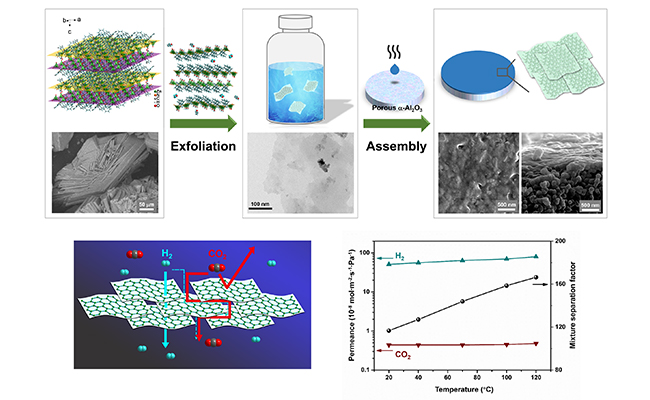
In the last few years, the researches on nanosheets-based molecular sieve membranes for gas separation have attracted extensive attention, which is due to the extraordinary molecular sieve efficiency and minimized mass-transfer barrier of these membranes.
Metal-organic framework (MOF) nanosheets are a new class of two-dimensional (2D) molecular sieve materials. They could be served as “building blocks” for ultrapermeable membranes because of their nanometer-sized thickness and large amount of regular pore arrays on the molecular scale.
The research group led by Prof. YANG Weishen from Dalian Institute of Chemical Physics (DICP) of the Chinese Academy of Sciences has made a progress on the exploration of MOF nanosheets and developed a novel MOF nanosheet-Zn2(Bim)3 for the first time based on their previous work. This work has been published in Angew. Chem. Int. Ed. (DOI: 10.1002/anie.201703959).
Previously, scientists from this group firstly prepared one-nanometer-thick MOF nanosheets by exfoliating a bulk lamellar of Zn2(bim)4 which was considered as MOF precursor, and further assembled these nanosheets into close-packed, highly interlocked MOF nanosheets membranes.
These new-developed membranes were the only ones that could reach the economically attractive region for pre-combustion CO2 capture. It showed unprecedented opportunities for gas separation technology, and gained extensive worldwide attention.
However, such defect-free nanosheets-based membranes were lack of eligible 2D MOF crystallographic structures and the preparation procedures of them were complicated. Both of these hindered the development of MOF nanosheets membranes with good separation performance.
In order to solve the above problems, scientists developed novel nanosheets-based molecular sieve membranes by using Zn2(Bim)3 as MOF precursor.
It was demonstrated that the H2/CO2 mixture separation performance of these membranes were among the top of all reported membranes: The separation factor could be up to 166 and the H2 permeance could be up to 8×10-7 mol m-2 s-1 Pa-1 at elevated testing temperatures, which is owing to a well-defined size exclusion effect.
This nanosheets membrane holds great promise as the next generation of ultrapermeable gas separation membrane. And in virtue of their distinctive amphiprotic natures, the novel 2D nanosheets could play a vital role in catalysis and electrochemistry applications.

Top: Representation of the precursor exfoliation and nanosheet assembly processes. Bottom: Illustration of the hypothesis of gas separation through a porous Zn2(Bim)3 nanosheets membrane and the separation performance vs. temperature data. (Image by PENG Yuan)
The above work is financially supported by the Strategic Priority Research Program of CAS and the National Natural Science Foundation of China.

86-10-68597521 (day)
86-10-68597289 (night)

52 Sanlihe Rd., Xicheng District,
Beijing, China (100864)

